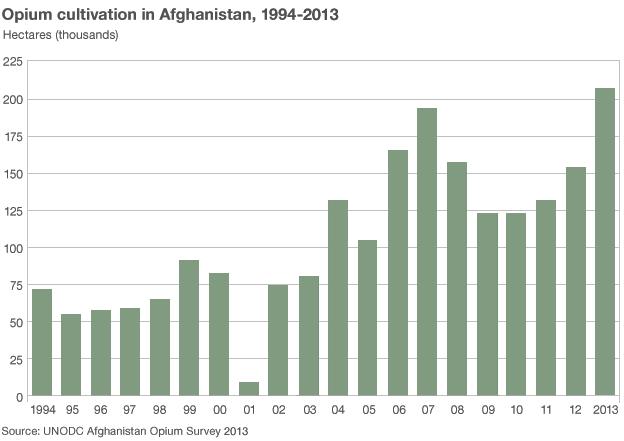Afghanistan: Before and after the Taliban
- Published
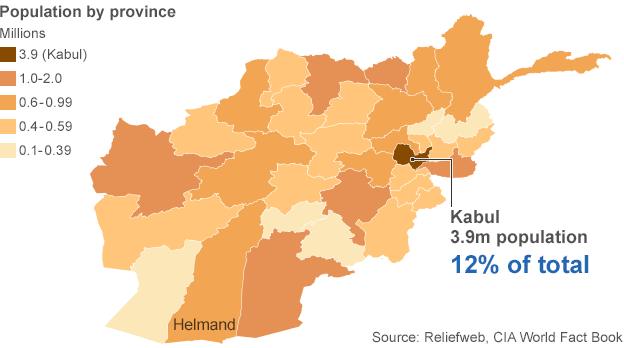
Afghanistan witnessed its first democratic transfer of power when Ashraf Ghani was sworn in as president in September 2014.
Since 2001, when the Taliban were ousted, thousands have been killed and billions of dollars spent trying to secure a peaceful future for the country's inhabitants.
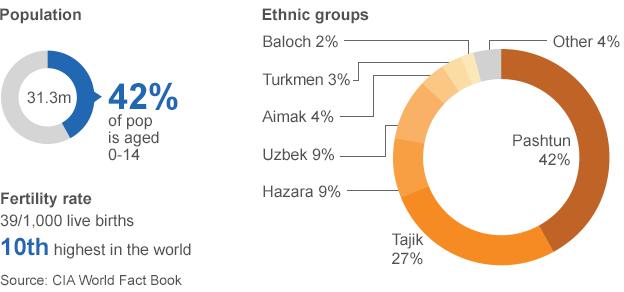
Afghanistan has a population of 31.3m and it is growing fast.
Afghan women get married young and typically have five children on average. According to the CIA World Factbook, the country has the 10th highest birth rate in the world.
Kabul is the capital of Afghanistan and is the country's largest city by far, with a population of about 3.3m. Kabul province is the only one in the country with a larger urban than rural population. According to the UN, 76% of Afghans still live in rural areas.
The Pashtuns are the largest ethnic group in Afghanistan, comprising about 42% of the population. The Tajiks are the second-largest group at 27%.
There are also about 1.5 million nomads, the ethnic Kuchis.
Education

The education system in Afghanistan is regarded as one of the country's biggest success stories since the Taliban were driven from power.
In 2001 no girls attended formal schools and there were only one million boys enrolled. By 2012 the World Bank says there were 7.8 million pupils attending school - including about 2.9 million girls.
However, many schools are still operating from tents, houses and under trees. The World Bank says of 180,000 teachers, only 52% meet the minimum standards required and the rest are receiving in-service training.
Girls' dropout rates are still very high in secondary schools and the country's adult literacy rate, 39% over the age of 15 can read and write, is one of the lowest in the world.
Women
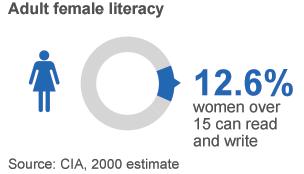
The position of women in Afghanistan has begun to improve. Under the Taliban they were barred from attending school and going out to work. Latest figures from the World Bank say 36% of girls are now enrolled in school - although many do not complete their secondary education and figures from 2007 suggest 52% of women were married by the age of 20.
Literacy among female adults is still very low - although official statistics are hard to come by. A report by the Central Statistsics Organisation/Unicef reported a literacy rate of 22.2% among women aged 15-24 in 2010/11.
Some women have begun to forge careers for themselves. More than a quarter of parliament and government employees are now women, according to charity Islamic Relief. A survey by the Central Statistics Oranisation (CSO) , externalin 2009 found women were being employed by government at a much faster rate than men. If the female growth rate continued, the share of female employees would be more than 40% by 2020.
Women are now also employed in the police and army. British officers have helped to establish a military training academy that aims to train 100 female army officers per year.
Despite the advances, violence against women is still a problem, with beatings, forced marriage and lack of economic support being listed as the top three offences reported by the CSO in 2010. Although the number of cases appears to be going down, the report also notes a new form of violence - prevention of women from taking part in social activities.
Poverty in Afghanistan, 2014
31.3m
Population
9m
In poverty
-
61% access to clean water
-
30% linked to electric power
-
28% have a flush toilet or latrine
The United Nations and its humanitarian partners are seeking US$406 million to provide five million people with essential, life-saving aid in 2014.
Afghanistan has one of the world's largest repatriated populations. Almost six million refugees have now returned home since the Taliban were ousted - and the UNHCR estimates just under two million of these still require support.
About 600,000 people are still recognised as internally displaced - most of them in the south and west of the country.
The proportion of the population of Afghanistan in poverty is estimated at 36% - although it varies from a relatively low 29% in urban areas to 36% in rural areas and 54% among the country's nomadic or Kuchi population.
In 2010 Afghanistan had the lowest gross national income per head of population among the developing countries in Asia, well below Bangladesh and Sri Lanka.
According to the CIA World Factbook, 78.6% of Afghanistan's population is employed in agriculture. In 2008 the unemployment rate was estimated to be 35%.
The number of people with access to the internet is now 5.5% - although many more people have access to mobile phones. The CIA World Factbook estimated there were 18 million mobile phones in circulation in the country in 2012.
Health
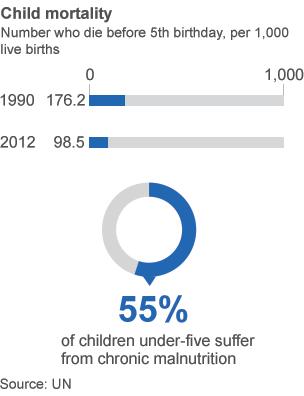
There have been big improvements in the country's health system.
Life expectancy has increased slightly from 56 to 60 years. But there have been big improvements in the under-five mortality rate and the maternal mortality rates.
According to the UN, access to safe drinking water improved from 4.8% of the population to 60.6% by 2011. Access to better sanitation, including private rather than shared toilets, has also improved to an average 37%. But the averages again mask big differences between urban and rural areas, with much less improvement in rural areas.
Vaccination campaigns continue to work towards the elimination of polio in Afghanistan, one of the last remaining countries where the disease remains endemic. In 2013 there were 14 reported cases, down from 37 in 2012.
Economy
Afghanistan's biggest export is still opium - despite attempts to persuade farmers to diversify. 2013 was a record year and the country produces 90% of the world's opium.
The high sale price of opium makes it difficult for farmers to resist. They also say promises to provide high-quality seeds and fertiliser have not been kept.
Other exports include fruit and nuts, handwoven carpets and wool.
Imports include machinery, food, textiles and petroleum products.
Afghanistan is said to have rich mineral reserves, including natural gas, which have not been exploited due to the political situation in the country.
It has one of the lowest rates of energy usage in the world. According to the World Bank only 28% of its population is connected to the national power grid and the service is unreliable. People in urban areas are more likely to be connected than the rural population.
